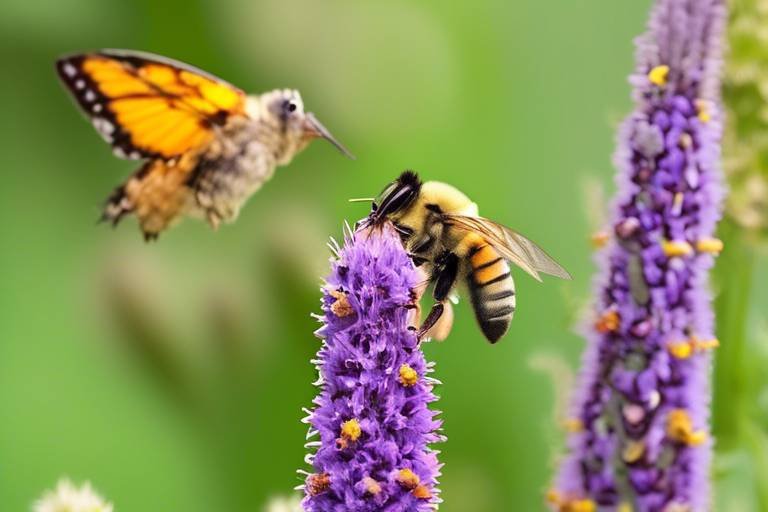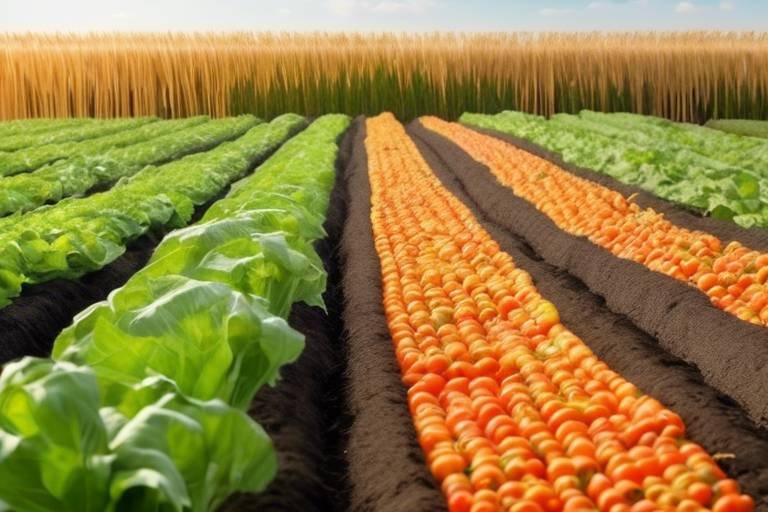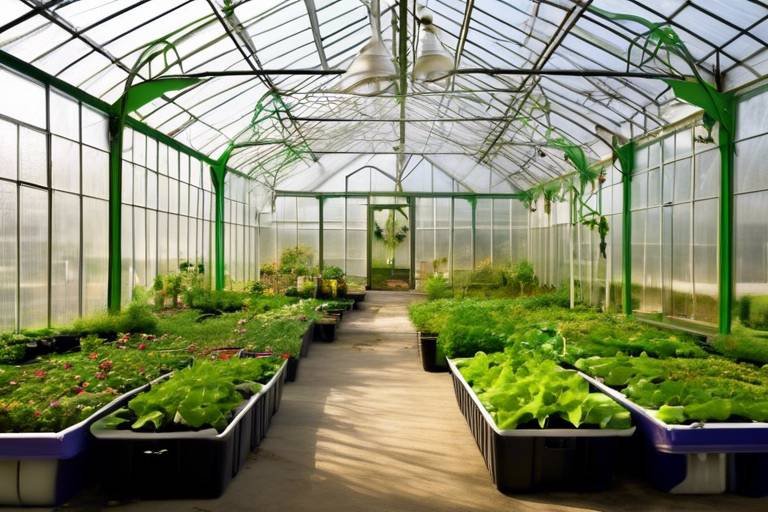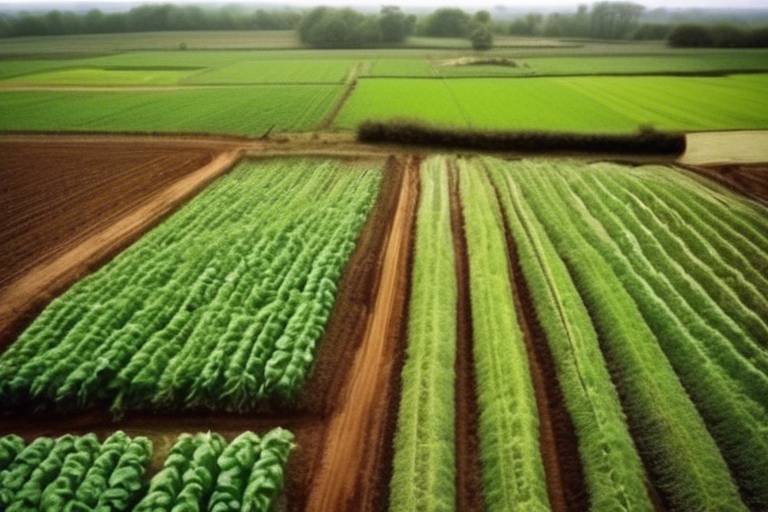Understanding the Role of Composting in Sustainable Farming
Composting is not just a trendy buzzword; it’s a vital practice that can revolutionize the way we approach agriculture. Imagine turning kitchen scraps and yard waste into a goldmine for your soil! That’s the magic of composting. In sustainable farming, it plays a crucial role by enhancing soil health, reducing waste, and promoting biodiversity. This trifecta leads to a more resilient agricultural ecosystem, one that can withstand the challenges posed by climate change and resource scarcity.
At its core, composting involves the natural process of breaking down organic materials into rich, fertile soil. This process is akin to nature’s own recycling system, where waste is transformed into nourishment for plants. By understanding the fundamental principles of composting, farmers can implement effective practices that not only benefit their crops but also the environment. It’s like giving back to the earth while reaping the rewards of healthier plants and improved yields.
One of the most significant advantages of composting is its ability to enrich soil. Healthy soil is the foundation of successful farming; it supports plant growth, enhances water retention, and reduces the reliance on chemical fertilizers. Think of compost as a multivitamin for your soil—packed with essential nutrients that plants crave. When farmers utilize compost, they are essentially investing in the long-term health of their land, ensuring that it remains productive for generations to come.
Moreover, composting significantly reduces agricultural waste. Every year, millions of tons of organic materials are discarded and sent to landfills, contributing to greenhouse gas emissions. By recycling these materials through composting, farmers can minimize waste and create a closed-loop system that benefits both their operations and the planet. Imagine a farm where nothing goes to waste; every scrap is transformed into something useful. That’s the power of composting!
In this article, we will explore various composting techniques that farmers can adopt, from hot composting to cold composting, each tailored to different scales and types of farming. By integrating composting into their practices, farmers can not only enhance their productivity but also contribute to a more sustainable future. Ready to dive deeper into the world of composting? Let’s get started!
Composting is a natural process that transforms organic waste into nutrient-rich soil. Understanding its fundamentals helps farmers implement effective composting practices that benefit their crops and the environment.
Composting enriches soil by improving its structure, water retention, and nutrient content. This section discusses how healthy soil supports plant growth and reduces the need for chemical fertilizers.
Compost improves soil aeration and drainage, which are essential for root development. This subheading delves into how better soil structure leads to healthier plants and increased crop yields.
Healthy compost enhances the soil's ability to retain moisture, reducing irrigation needs. This section explains how this benefit is crucial in drought-prone areas.
Composting increases the availability of essential nutrients to plants. Here, we discuss the specific nutrients provided by compost and their role in plant health.
Composting helps minimize waste by recycling organic materials that would otherwise end up in landfills. This section highlights the importance of waste reduction in sustainable farming practices.
Various composting methods exist, each suited for different farming scales and types. This section outlines practical techniques that farmers can adopt to create effective compost.
Hot composting accelerates the decomposition process, resulting in nutrient-rich compost in a shorter time. This subheading covers the steps and benefits of this efficient method.
Cold composting is a slower process that requires less maintenance. Here, we explore how this method can be beneficial for farmers with less time or resources to dedicate to composting.
- What materials can I compost? Almost any organic material, such as fruit and vegetable scraps, grass clippings, leaves, and coffee grounds, can be composted.
- How long does it take to make compost? The composting process can take anywhere from a few weeks to several months, depending on the method used.
- Can I compost in an apartment? Yes! There are various indoor composting methods, such as vermicomposting (using worms) or bokashi composting.
- Is composting difficult? Not at all! With a little knowledge and practice, anyone can successfully compost.

The Basics of Composting
This article explores how composting contributes to sustainable farming practices, enhancing soil health, reducing waste, and promoting biodiversity, ultimately leading to a more resilient agricultural ecosystem.
Composting is a natural process that transforms organic waste into nutrient-rich soil. Imagine taking your kitchen scraps, yard waste, and other biodegradable materials and turning them into black gold for your garden. It’s like giving back to the Earth what it once provided us. But how does this magical transformation happen? At its core, composting is all about microorganisms—the tiny creatures that break down organic matter and turn it into something beneficial. Understanding its fundamentals helps farmers implement effective composting practices that benefit their crops and the environment.
So, what exactly can be composted? The list is extensive, but it generally includes:
- Fruit and vegetable scraps
- Grass clippings
- Leaves
- Eggshells
- Coffee grounds
- Shredded paper and cardboard
However, not everything is suitable for composting. It’s important to avoid items like meat, dairy, and oily foods, as they can attract pests and create odors. The balance of greens (nitrogen-rich materials) and browns (carbon-rich materials) is crucial for the composting process. A good rule of thumb is to aim for a ratio of about 1 part greens to 3 parts browns. This balance helps create an ideal environment for microorganisms to thrive.
The composting process generally involves four key stages: thermophilic, cooling, maturation, and curing. During the thermophilic stage, temperatures can soar, killing off pathogens and weed seeds. As the materials cool, they enter the maturation phase, where the compost begins to stabilize. Finally, curing allows the compost to rest, ensuring it’s ready to enrich your soil. This process can take anywhere from a few weeks to several months, depending on the method used and the materials involved.
In addition to improving soil health, composting also plays a significant role in reducing waste. Did you know that a substantial portion of what we throw away is organic material? By composting, farmers can recycle these materials, significantly decreasing the volume of waste sent to landfills. This not only conserves space but also reduces greenhouse gas emissions associated with waste decomposition in landfills.
Ultimately, mastering the basics of composting is an essential skill for any sustainable farmer. It’s not just about creating compost; it’s about fostering a thriving ecosystem that supports plant growth, enhances soil health, and contributes to a more sustainable future. So, roll up your sleeves, get your hands dirty, and start composting!
What materials can I compost?
You can compost fruit and vegetable scraps, grass clippings, leaves, eggshells, and coffee grounds. Avoid meat, dairy, and oily foods.
How long does the composting process take?
The composting process can take anywhere from a few weeks to several months, depending on the method and materials used.
Why is the balance of greens and browns important?
Maintaining a proper ratio of nitrogen-rich greens to carbon-rich browns is crucial for creating an ideal environment for microorganisms to thrive.
Can composting reduce waste?
Absolutely! Composting helps recycle organic materials that would otherwise end up in landfills, significantly reducing waste and greenhouse gas emissions.

Benefits of Composting for Soil Health
Composting is not just a trend; it’s a revolution in sustainable farming that brings a plethora of benefits to soil health. When organic materials decompose, they create compost, which is a powerhouse of nutrients. This nutrient-rich substance plays a pivotal role in enhancing soil quality, and in turn, supports robust plant growth. Imagine your soil as a sponge—when it’s healthy and full of compost, it can absorb and retain water and nutrients like no other. This is crucial for farmers who want to reduce their reliance on synthetic fertilizers and promote a more natural growing environment.
One of the standout benefits of composting is its ability to improve soil structure. Healthy soil isn’t just dirt; it’s a living ecosystem. Compost helps to create aggregates in the soil, which are small clumps that improve aeration and drainage. Think of it as giving your soil a makeover—when it looks good, it performs even better! With improved aeration, plant roots can breathe and grow more effectively. This leads to stronger plants that are more resilient to pests and diseases.
When compost is added to the soil, it transforms the texture, making it crumbly and loose. This is essential for root development. Roots need space to grow and access nutrients, and compost creates that space. A well-structured soil allows for better moisture infiltration, reducing runoff and erosion. Farmers who incorporate compost into their soil management practices often see a noticeable increase in crop yields. It’s like giving your plants a solid foundation to thrive on!
Another incredible benefit of compost is its ability to enhance water retention. Healthy compost can hold several times its weight in water, which is a game changer for farmers, especially in regions prone to drought. This means that during dry spells, crops can access the moisture they need to survive and flourish without the constant need for irrigation. It’s like having a reservoir of water right in your soil! By reducing irrigation needs, compost not only saves water but also lowers costs for farmers, making it a win-win situation.
Composting also boosts the availability of essential nutrients in the soil. Nutrients such as nitrogen, phosphorus, and potassium are crucial for plant health, and compost provides these in a slow-release form. This means that plants can absorb them over time, leading to sustained growth without the risk of nutrient burn that can occur with chemical fertilizers. The rich microbial life in compost further aids in breaking down these nutrients, making them more accessible to plants. It’s like having a buffet of nutrients available for your crops to feast on!
In summary, the benefits of composting for soil health are profound. From enhancing soil structure and water retention to increasing nutrient availability, compost is a farmer's best friend. By adopting composting practices, farmers not only improve their soil but also contribute to a healthier ecosystem. Let’s embrace composting and watch our soils—and our crops—thrive!
- What materials can I compost? You can compost kitchen scraps like fruit and vegetable peels, coffee grounds, eggshells, and yard waste such as leaves and grass clippings.
- How long does it take to make compost? Depending on the method used, compost can take anywhere from a few weeks to a few months to fully decompose.
- Can I compost in an apartment? Yes! You can use a small compost bin or a worm composting system, also known as vermicomposting.
- Is composting difficult? Not at all! With a bit of knowledge and practice, anyone can start composting and enjoy the benefits.

Enhancing Soil Structure
When it comes to farming, the foundation of success lies in the soil. Just like a house needs a solid base, crops require healthy, well-structured soil to thrive. Composting plays a pivotal role in enhancing soil structure, which in turn supports robust plant growth. But how does this magic happen? Well, compost acts like a superhero for your soil, transforming it into a living ecosystem filled with nutrients and beneficial microorganisms.
One of the key benefits of compost is its ability to improve soil aeration. Imagine trying to breathe in a crowded room; it’s tough, right? Plants experience something similar when soil is compacted. Compost helps break up heavy soils, allowing air to circulate freely. This aeration is essential for root development, as roots need oxygen just as much as they need water and nutrients. With improved aeration, plants can grow deeper and stronger, leading to healthier crops and, ultimately, a better yield.
Moreover, compost enhances soil drainage, preventing waterlogging, which can be detrimental to plant health. Think of it as a sponge; compost soaks up excess water and releases it slowly, ensuring that plants have access to moisture without drowning in it. This balance is crucial, especially in areas prone to heavy rainfall. A well-drained soil structure not only supports plant health but also reduces erosion, keeping precious topsoil intact.
Another significant aspect of composting is its impact on soil aggregation. When organic materials break down, they bind together, forming clusters known as aggregates. These aggregates create spaces in the soil, allowing for better water infiltration and root penetration. As a result, plants can access nutrients more efficiently, which is vital for their growth. The relationship between soil structure and plant health is like a dance; when one partner moves gracefully, the other follows suit.
To illustrate the benefits of enhanced soil structure, consider the following table that compares soil properties before and after compost application:
| Soil Property | Before Composting | After Composting |
|---|---|---|
| Aeration | Poor | Improved |
| Drainage | Compacted | Well-drained |
| Nutrient Availability | Limited | Increased |
| Water Retention | Low | High |
In summary, enhancing soil structure through composting is not just a technique; it’s a game-changer for sustainable farming. By improving aeration, drainage, and nutrient availability, compost helps create a thriving environment for plants. Farmers who embrace composting are essentially investing in the future of their crops and the health of their land.
- What types of materials can be composted? Almost any organic material can be composted, including kitchen scraps, yard waste, and even some paper products.
- How long does it take to make compost? The composting process can take anywhere from a few weeks to several months, depending on the method used and the materials involved.
- Can I use compost in my garden? Absolutely! Compost is a fantastic addition to any garden, enriching the soil and promoting healthy plant growth.

Water Retention Capabilities
When it comes to farming, water is as precious as gold. Imagine your crops thriving in the midst of a drought, their roots digging deep into the soil, searching for moisture. This is where composting plays a pivotal role. Compost not only enriches the soil with nutrients but also significantly enhances its . This means that when rain does fall, or when you irrigate, the soil holds onto that moisture much longer.
How does this magic happen? Well, compost is made up of a variety of organic materials, such as kitchen scraps, yard waste, and even manure. These materials decompose into a rich, dark substance that acts like a sponge, soaking up water and holding it in the soil for plants to use. This is especially crucial in areas that experience drought or inconsistent rainfall. Farmers who incorporate compost into their soil can reduce their irrigation needs, which not only saves water but also cuts down on costs.
Let’s break it down further. The structure of compost creates tiny air pockets within the soil. These pockets are essential for trapping moisture, allowing it to be available for plants over an extended period. Without compost, soil can become compacted, leading to poor aeration and drainage, which ultimately results in water running off instead of being absorbed. In contrast, healthy composted soil retains up to 30% more water compared to non-composted soil. This translates to a more resilient crop, capable of withstanding periods of dryness.
To give you a clearer picture, here’s a simple comparison:
| Soil Type | Water Retention Capacity |
|---|---|
| Non-Composted Soil | Low |
| Composted Soil | High |
By utilizing compost, farmers can create a more sustainable farming environment. Not only does this practice promote better water management, but it also fosters a healthy ecosystem. When the soil retains moisture effectively, plants can grow stronger and healthier, leading to increased yields. Plus, with less reliance on irrigation, farmers can help conserve valuable water resources, contributing to the overall sustainability of their agricultural practices.
In conclusion, the water retention capabilities of compost are a game-changer for farmers. By adopting composting practices, they can ensure their crops have access to the moisture they need to thrive, even in challenging climates. Isn’t it fascinating how a simple natural process can lead to such significant improvements in farming?
- What is composting? Composting is the process of turning organic waste into nutrient-rich soil through natural decomposition.
- How does compost improve water retention? Compost enhances soil structure, creating air pockets that trap moisture, allowing for better water absorption.
- Can composting reduce irrigation needs? Yes, by improving water retention, compost can significantly lower the amount of water needed for irrigation.
- What materials can be composted? Common compostable materials include fruit and vegetable scraps, yard waste, coffee grounds, and eggshells.

Nutrient Availability
When it comes to farming, is like the lifeblood of your crops. Without the right nutrients, plants struggle to grow, much like a person trying to run a marathon on an empty stomach. Composting plays a critical role in enhancing this nutrient availability by breaking down organic matter into a form that plants can easily absorb. This transformation is not just a magical process; it involves a complex interaction of microorganisms that convert raw materials into essential nutrients.
Compost is rich in a variety of nutrients that are vital for plant health. Some of the key nutrients found in compost include:
- Nitrogen - Essential for leaf growth and overall plant vigor.
- Phosphorus - Crucial for root development and flowering.
- Potassium - Helps in water regulation and disease resistance.
- Calcium - Important for cell wall structure and growth.
- Magnesium - A core component of chlorophyll, aiding in photosynthesis.
The beauty of compost lies in its ability to release these nutrients slowly over time. This slow-release mechanism means that instead of flooding the soil with synthetic fertilizers that can leach away or cause nutrient burn, compost provides a steady supply of nutrients. Think of it as a slow-cooked meal that nourishes you throughout the day rather than a quick snack that leaves you hungry again shortly after.
Moreover, compost also enhances the soil's microbial activity, which is essential for nutrient cycling. Healthy soil teeming with life is better at breaking down organic matter and making nutrients available to plants. This symbiotic relationship between compost and soil health creates a robust ecosystem that supports not only the plants but also the beneficial organisms that contribute to a thriving agricultural environment.
In summary, the nutrient availability provided by composting is a game-changer for sustainable farming. By enriching the soil with essential nutrients, compost not only supports plant growth but also reduces the dependency on chemical fertilizers, leading to healthier crops and a more sustainable farming practice. The result? A flourishing farm ecosystem that benefits everyone involved—from the farmers to the consumers.
Q1: How long does it take for compost to be ready to use?
A1: The time it takes for compost to mature can vary based on the method used. Hot composting can take as little as 3-6 weeks, while cold composting may take several months to a year.
Q2: Can I compost meat and dairy products?
A2: It's generally not recommended to compost meat and dairy as they can attract pests and create odors. Stick to vegetable scraps, fruit peels, and yard waste for best results.
Q3: How do I know if my compost is ready?
A3: Finished compost should be dark, crumbly, and have an earthy smell. If you still see recognizable food scraps or a strong odor, it likely needs more time to decompose.
Q4: Is it necessary to turn compost?
A4: Turning compost helps aerate the pile and speeds up the decomposition process, but it's not strictly necessary, especially for cold composting methods.

Reducing Agricultural Waste
In today’s world, where environmental concerns are at an all-time high, has become more than just a buzzword; it’s a necessity. Composting plays a crucial role in this endeavor by recycling organic materials that would otherwise contribute to the ever-growing landfills. Imagine a farm where every leftover vegetable, fruit peel, and even grass clippings find a second life instead of rotting away in a dump. This not only minimizes waste but also transforms it into a valuable resource for the soil.
When we talk about agricultural waste, we’re referring to a variety of materials, including:
- Crop residues
- Animal manure
- Food scraps from farm operations
- Plant trimmings
By composting these materials, farmers can significantly reduce the volume of waste they produce, which is essential for sustainable farming practices. Not only does this practice help in managing waste, but it also promotes a circular economy within the farming ecosystem. Instead of viewing waste as a problem, farmers can see it as an opportunity to create something beneficial.
Furthermore, when organic waste decomposes in landfills, it generates methane, a potent greenhouse gas that contributes to climate change. By composting, farmers can help mitigate this issue. Composting not only diverts waste from landfills but also enhances soil health, which is vital for growing healthy crops. The cycle of composting—where waste turns into nutrient-rich compost—demonstrates the beauty of nature’s recycling process.
Additionally, the practice of composting encourages farmers to be more mindful of their waste management strategies. It pushes them to consider what materials they can repurpose, leading to innovative practices that can further reduce waste. For instance, farmers might start incorporating cover crops or crop rotation strategies that help utilize organic waste more effectively. This proactive approach not only reduces waste but also fosters a more resilient agricultural system.
In summary, composting is a powerful tool in the fight against agricultural waste. It allows farmers to transform organic materials into a resource, reduces landfill contributions, and promotes environmental sustainability. As we move forward, embracing composting can lead to a more efficient and environmentally friendly agricultural sector, ultimately benefiting both the farmers and the planet.
Q: What types of materials can be composted?
A: Almost all organic materials can be composted, including fruit and vegetable scraps, grass clippings, leaves, and even small amounts of paper and cardboard. However, it’s essential to avoid meat, dairy, and oily foods, as they can attract pests.
Q: How long does it take to create compost?
A: The time it takes to create compost can vary based on the method used. Hot composting can take as little as 4-6 weeks, while cold composting may take several months to a year.
Q: Can composting help with soil erosion?
A: Yes! Compost improves soil structure, enhances water retention, and promotes healthy root growth, which can help reduce soil erosion.
Q: Is composting difficult to start?
A: Not at all! Starting a compost pile is simple. All you need is a mix of green (nitrogen-rich) and brown (carbon-rich) materials, moisture, and a little time. With some basic guidelines, anyone can start composting.

Composting Techniques for Farmers
When it comes to composting, farmers have a variety of techniques at their disposal, each with its own set of advantages and challenges. The choice of method often depends on the scale of the farm, the types of materials available, and the time and resources a farmer can dedicate to the process. Understanding these techniques can significantly enhance the efficiency of composting efforts, leading to better soil health and, ultimately, more productive crops.
One of the most popular methods is hot composting. This technique involves creating a compost pile that reaches high temperatures, typically between 130°F and 160°F (54°C to 71°C). The heat generated during this process accelerates the decomposition of organic materials, resulting in nutrient-rich compost in a matter of weeks rather than months. To achieve this, farmers need to ensure they have a balanced mix of "greens" (nitrogen-rich materials like kitchen scraps and grass clippings) and "browns" (carbon-rich materials like dried leaves and straw). The ideal ratio is about 2:1, browns to greens. Regular turning of the pile is also crucial to maintain aeration and temperature.
In contrast, cold composting offers a more laid-back approach. This method requires less maintenance and is perfect for farmers who may not have the time or resources to manage a hot compost pile. Cold composting involves simply layering organic materials and allowing them to decompose naturally over a longer period, often taking six months to a year. While this method is slower, it still produces high-quality compost and is less labor-intensive. Farmers can simply add materials as they accumulate, making it a convenient option for those with busy schedules.
For farmers looking to maximize their composting efforts, vermicomposting is another innovative technique that utilizes worms to break down organic matter. This method is not only efficient but also produces a potent type of compost known as worm castings, which are rich in nutrients and beneficial microorganisms. Setting up a vermicomposting system can be as simple as having a bin with bedding material and adding red wiggler worms, which thrive on kitchen scraps and other organic waste. The result is a highly concentrated compost that can significantly boost plant growth.
Moreover, farmers can also explore bokashi composting, a fermentation-based method that allows for the composting of a wider variety of organic materials, including meat and dairy, which are typically not recommended for traditional composting methods. Bokashi involves layering food waste with a special mix of bran, molasses, and microorganisms, which ferment the waste in an airtight container. After a few weeks, the fermented material can be buried in the soil, where it will break down further and enrich the soil.
Regardless of the method chosen, it’s essential for farmers to monitor their compost piles regularly. Keeping an eye on moisture levels, temperature, and the balance of materials will ensure a successful composting process. Each technique has its own unique benefits, and farmers may even find that a combination of methods works best for their specific needs.
- What materials can I compost? Most organic materials such as fruit and vegetable scraps, grass clippings, leaves, and coffee grounds can be composted. Avoid meat, dairy, and oily foods in traditional composting.
- How long does it take to make compost? Hot composting can take as little as 4 to 6 weeks, while cold composting can take several months to a year.
- Can I compost in winter? Yes, composting can continue in winter, though the process may slow down. Insulating your compost pile can help maintain heat.
- How do I know my compost is ready? Finished compost should be dark, crumbly, and have an earthy smell. If you can’t recognize the original materials, it’s likely ready to use.

Hot Composting
Hot composting is a dynamic and efficient method that accelerates the decomposition of organic materials, transforming them into nutrient-rich compost in a remarkably short period. This method relies on maintaining high temperatures within the compost pile, usually between 130°F to 160°F (54°C to 71°C), which not only speeds up the breakdown process but also helps in killing off pathogens and weed seeds. Imagine a bustling kitchen where ingredients are rapidly cooked to perfection; that’s what hot composting feels like in the world of organic waste!
To get started with hot composting, it’s essential to understand the right balance of materials. You need a mix of green materials (like kitchen scraps, grass clippings, and manure) that are rich in nitrogen, and brown materials (such as dried leaves, straw, and cardboard) that provide carbon. The ideal ratio is typically around 30:1 carbon to nitrogen. When these materials are layered correctly, the microorganisms get to work, generating heat as they break down the organic matter. This process can yield finished compost in as little as 4 to 6 weeks!
Here’s a simple breakdown of the hot composting process:
| Step | Description |
|---|---|
| 1. Gather Materials | Collect a mix of green and brown materials. |
| 2. Build the Pile | Layer materials in a compost bin or pile, ensuring good airflow. |
| 3. Monitor Temperature | Use a compost thermometer to check the internal temperature regularly. |
| 4. Turn the Pile | Every few weeks, turn the pile to aerate it and maintain the heat. |
| 5. Harvest Compost | After 4-6 weeks, your compost should be dark, crumbly, and ready to use! |
One of the standout benefits of hot composting is its ability to produce compost quickly, making it ideal for farmers who need a regular supply of organic matter to enrich their soil. It’s like having a fast-food option for compost creation! Moreover, because the high temperatures kill harmful pathogens, the resulting compost is not only rich in nutrients but also safe for use in gardens and on crops.
However, hot composting does require a bit more attention than other methods. Farmers must regularly monitor the moisture levels and temperature of the pile, ensuring it remains active and productive. A well-maintained hot compost pile can be a game-changer, offering a sustainable solution to waste management and soil enrichment. So, if you’re looking to supercharge your composting efforts, hot composting might just be the fiery boost you need!
- What materials can I use for hot composting? You can use a variety of organic materials, including fruit and vegetable scraps, grass clippings, leaves, and even small branches.
- How often should I turn my compost pile? It's recommended to turn your compost pile every 1-2 weeks to maintain aeration and temperature.
- Can I compost meat or dairy products? It's best to avoid composting meat and dairy as they can attract pests and create odors.
- How do I know when my compost is ready? Finished compost will be dark, crumbly, and have an earthy smell; it should be unrecognizable from the original materials.

Cold Composting
Cold composting is like a laid-back approach to creating compost. Unlike its hot counterpart, which speeds up the decomposition process with high temperatures, cold composting takes its sweet time. It’s perfect for those who might not have the time or energy to monitor a hot compost pile constantly. Imagine it as letting a fine wine age; the longer it sits, the better it gets!
One of the beauties of cold composting is its simplicity. You can start with a pile of kitchen scraps, yard waste, and other organic materials, and just let nature do its thing. Over time, microorganisms and worms will break down the materials, turning them into rich, dark compost. This method requires minimal effort, making it an ideal choice for busy farmers or gardeners who want to enrich their soil without intense labor.
However, patience is key. Cold composting can take anywhere from six months to a year to produce usable compost, depending on the materials used and environmental conditions. To optimize this process, it’s helpful to follow a few guidelines:
- Layer Wisely: Start with coarse materials like twigs and straw at the bottom to promote airflow, then alternate layers of green (nitrogen-rich) and brown (carbon-rich) materials.
- Keep it Moist: The compost pile should be damp but not soggy. A good rule of thumb is to aim for the moisture level of a wrung-out sponge.
- Aeration: While cold composting doesn’t require turning the pile as often as hot composting, occasional aeration can speed up the process. Simply mix the materials with a pitchfork every few months.
Despite its slower pace, cold composting has its advantages. It’s less labor-intensive, requires fewer resources, and can be done year-round. Plus, it’s a great way to recycle kitchen scraps and yard waste, reducing the burden on landfills. As the organic materials break down, they create a habitat for beneficial organisms, contributing to a thriving ecosystem in your garden or farm.
In conclusion, cold composting is a fantastic option for those looking to enrich their soil without a lot of fuss. It allows you to make good use of organic waste while promoting a healthier environment. Just remember, good things come to those who wait, and the end result—a nutrient-rich compost—will be well worth the wait!
1. How long does cold composting take?
Cold composting typically takes between six months to a year, depending on the materials used and environmental conditions.
2. What materials can I use for cold composting?
You can use kitchen scraps, yard waste, cardboard, paper, and other organic materials. Just ensure a balance between nitrogen-rich greens and carbon-rich browns.
3. Do I need to turn the pile?
While turning the pile is not necessary, occasional aeration can help speed up the decomposition process.
4. Can I compost in winter?
Yes, cold composting can be done year-round. Just be aware that decomposition may slow down in colder temperatures.
Frequently Asked Questions
- What is composting and why is it important for sustainable farming?
Composting is the process of recycling organic waste, like food scraps and yard waste, into a nutrient-rich soil amendment. It's crucial for sustainable farming because it enhances soil health, reduces the need for chemical fertilizers, and minimizes agricultural waste, fostering a more resilient ecosystem.
- How does composting improve soil health?
Composting enriches the soil by improving its structure, increasing water retention, and making essential nutrients more available to plants. This leads to healthier crops, better root development, and ultimately higher yields, all while reducing dependency on synthetic fertilizers.
- What are the different composting techniques available for farmers?
Farmers can choose from various composting methods, such as hot composting, which speeds up decomposition and produces compost quickly, and cold composting, which is a slower process that requires less maintenance. Each method has its benefits depending on the farmer's resources and time.
- Can composting help in drought-prone areas?
Absolutely! Healthy compost enhances the soil's ability to retain moisture, which is particularly beneficial in drought-prone regions. This means farmers can reduce their irrigation needs while still cultivating robust crops.
- What types of materials can be composted?
Most organic materials can be composted, including fruit and vegetable scraps, coffee grounds, eggshells, grass clippings, and leaves. However, it's important to avoid composting meat, dairy, and oily foods, as these can attract pests and create odors.
- How long does it take to produce compost?
The time it takes to produce compost varies based on the method used. Hot composting can yield finished compost in as little as 4-6 weeks, while cold composting may take several months to a year. Factors like temperature, moisture, and the materials used also influence the timeline.
- Is composting difficult to manage?
Not at all! While some methods like hot composting require more attention and management, cold composting is quite easy and requires minimal effort. Farmers can choose a method that fits their lifestyle and resources.
- What are the environmental benefits of composting?
Composting significantly reduces landfill waste, decreases greenhouse gas emissions, and promotes biodiversity by enriching the soil. It plays a vital role in creating a sustainable agricultural ecosystem that benefits both the environment and farming communities.



















